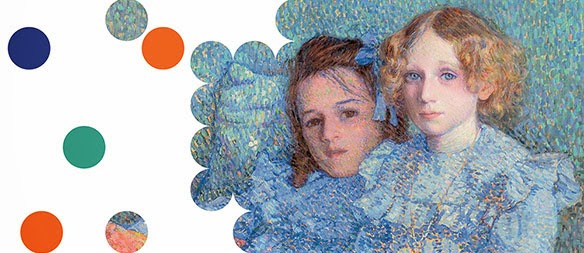DONT LET POINTS GET YOU DOWN........
and I must admit that I do not remember visiting the ING art centre in Brussels. An invitation arrived at the beginning of February - I hesitated for a few minutes - would I go or not? The hesitation was quite simply due to the fact that this is not my period and seeing pretty people in the Neo-Impressionist style has never really appealed to me. Last year though I had seen the musical « Sunday in the Park » (with George) - Sondheim and had been enchanted. Through the singing alone I understood a lot more how this pointillist period had been developed. So I would go.
In Paris it was bright and sunny when the train left early in the morning. That was nice as I was not dressed too warmly. Brussels was freezing and even before getting to the centre, my teeth were chattering. It was not much warmer inside either. After showing my Icom card, I was then informed that my bag and coat must be left in the cloakroom. « But I’m frozen » was the pathetic squeak that came out of my mouth. Would you believe that the reply was « we all are Madame, but rules are rules…. » Entering the exhibition it was obvious that the locals knew what to expect. I was in a light woolen jumper - they were wearing thick jumpers and scarves….my visit was not a happy one.
Naturally no photos. At least the description on Internet is clear.
« Originating in Paris, and a real turning point in the history of painting at the end of the 19th century, the Neo-Impressionist movement developed in a unique way in Brussels.
In 1886, Georges Seurat exhibited his painting "A Sunday Afternoon on the Island of La Grande Jatte" in Paris. Noticing the modernity of this masterpiece, his Belgian contemporaries invited Seurat to exhibit the work the following year at the Salon des XX. The work inspired both the artists of this Brussels circle and artists invited from other European countries. The revolutionary theory of Neo-Impressionism was welcomed enthusiastically in Brussels, which rapidly became a platform for the exchange of progressive ideas.
The Neo-Impressionist movement revolved around two axes. The French school, with protagonists as Georges Seurat, Paul Signac, Lucien Pissarro, Maximilien Luce, Henri Delavallée, Henri-Edmond Cross and Achille Laugé, used this technique in its search into light and colour, recomposed by the eye through juxtaposed points of pure colour. In terms of the portrait, the French school conveyed the idea of the effigy portrait, with its neutrality and precise objectivity.
Belgian artists however, in particular Henry Van de Velde, Georges Lemmen, George Morren, Théo Van Rysselberghe and William Jelley, demonstrated that this divisionist colour technique could be perfectly applied for creating intimate and psychological portraits, with great depth and meticulousness in their use of light. »
 | |||
| Albert Dubois - Portrait of Mr Pool -1887 |
 |
| Lucien Pissaro - Interior of the Study - 1890 |
 |
| Henru Delvallé - The Boot Polisher - 1890 |
 |
| Georges Lemmen - The Two sisters 1894 |
 |
| Maximilien Luce - Morning, Interior 1890 |
 |
| Achille laugé - Against the light - 1889 |




Commentaires